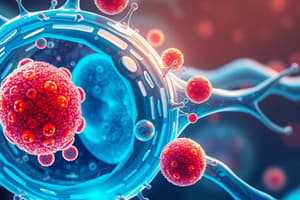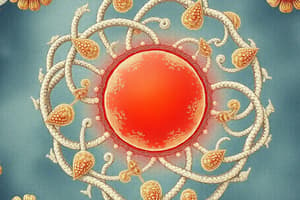Podcast
Questions and Answers
What is the basic structural and functional unit of all tissues in the body?
What is the basic structural and functional unit of all tissues in the body?
- The organelle
- The tissue
- The cell (correct)
- The organ
Which type of cell contains a nuclear envelope?
Which type of cell contains a nuclear envelope?
- Viral cell
- Eukaryotic cell (correct)
- Bacterial cell
- Prokaryotic cell
Which membranous organelle is known as the powerhouse of the cell?
Which membranous organelle is known as the powerhouse of the cell?
- Mitochondria (correct)
- Endoplasmic reticulum
- Lysosome
- Golgi apparatus
What is the main function of the rough endoplasmic reticulum (RER)?
What is the main function of the rough endoplasmic reticulum (RER)?
What role do lysosomes play in the cell?
What role do lysosomes play in the cell?
Which part of the cell membrane is primarily responsible for regulating transport?
Which part of the cell membrane is primarily responsible for regulating transport?
What do peroxisomes primarily help in metabolizing?
What do peroxisomes primarily help in metabolizing?
Which of these components is NOT a part of the cell?
Which of these components is NOT a part of the cell?
What is the primary role of phospholipids in the cell membrane?
What is the primary role of phospholipids in the cell membrane?
How does cholesterol affect the cell membrane?
How does cholesterol affect the cell membrane?
What is the function of integral proteins in the plasma membrane?
What is the function of integral proteins in the plasma membrane?
Which of the following components contributes to cell signaling and recognition?
Which of the following components contributes to cell signaling and recognition?
What component of the plasma membrane is involved in adhesion to the extracellular matrix?
What component of the plasma membrane is involved in adhesion to the extracellular matrix?
What characteristic do hydrophilic heads of phospholipids display?
What characteristic do hydrophilic heads of phospholipids display?
What role do carbohydrates play in the plasma membrane?
What role do carbohydrates play in the plasma membrane?
What is a key function of peripheral proteins?
What is a key function of peripheral proteins?
Flashcards
Eukaryotic Cell
Eukaryotic Cell
A type of cell that has a nucleus and other membrane-bound organelles.
Prokaryotic Cell
Prokaryotic Cell
A type of cell that lacks a nucleus and membrane-bound organelles.
Mitochondria
Mitochondria
Organelle that produces energy (ATP) for the cell through cellular respiration.
Endoplasmic Reticulum (ER)
Endoplasmic Reticulum (ER)
Signup and view all the flashcards
Rough Endoplasmic Reticulum (RER)
Rough Endoplasmic Reticulum (RER)
Signup and view all the flashcards
Smooth Endoplasmic Reticulum (SER)
Smooth Endoplasmic Reticulum (SER)
Signup and view all the flashcards
Golgi Apparatus
Golgi Apparatus
Signup and view all the flashcards
Lysosomes
Lysosomes
Signup and view all the flashcards
Vesicles
Vesicles
Signup and view all the flashcards
Peroxisomes
Peroxisomes
Signup and view all the flashcards
Cell Membrane
Cell Membrane
Signup and view all the flashcards
Lipid Bilayer
Lipid Bilayer
Signup and view all the flashcards
Cell Signaling
Cell Signaling
Signup and view all the flashcards
Cell Adhesion
Cell Adhesion
Signup and view all the flashcards
Phospholipid Bilayer
Phospholipid Bilayer
Signup and view all the flashcards
Hydrophilic Head
Hydrophilic Head
Signup and view all the flashcards
Hydrophobic Tail
Hydrophobic Tail
Signup and view all the flashcards
Cholesterol
Cholesterol
Signup and view all the flashcards
Integral Protein
Integral Protein
Signup and view all the flashcards
Peripheral Protein
Peripheral Protein
Signup and view all the flashcards
Glycolipid
Glycolipid
Signup and view all the flashcards
Glycoprotein
Glycoprotein
Signup and view all the flashcards
Membrane Function
Membrane Function
Signup and view all the flashcards
Study Notes
Cell Biology Lecture 2
- Cells are the basic structural and functional units of all tissues and life.
- Eukaryotic cells: have a nuclear envelope and membrane-bound organelles; found in animals and plants.
- Prokaryotic cells: lack a nuclear envelope and membrane-bound organelles; found in bacteria.
- Cell components include cytoplasm, nucleus, cytosol, organelles, cytoskeleton, and cell membrane.
- Cell membrane separates cytoplasm from the external environment.
Membranous Organelles
- Mitochondria: Powerhouses of the cell producing ATP through cellular respiration. Contain their own DNA and regulate the cell cycle.
- Endoplasmic Reticulum (ER):
- Rough ER: Has ribosomes for protein synthesis.
- Smooth ER: Involved in lipid synthesis and calcium storage.
- Golgi Apparatus: Modifies, sorts, and packages proteins and lipids; forms vesicles to transport materials to target locations.
- Lysosomes: Contain digestive enzymes breaking down unwanted materials; play a role in cellular recycling.
- Vesicles: Transport materials within or outside the cell; include secretory and endocytic vesicles.
- Peroxisomes: Contain enzymes breaking down fatty acids and detoxifying harmful substances; play a role in cellular metabolism.
Cell Membrane
- The cell membrane (plasma membrane/plasmalemma) is a thin structure surrounding the cell.
- Composition: Lipid bilayer (50%), proteins, and carbohydrates.
- Functions:
- Regulation of transport: Acts as a barrier regulating ion and solute passage through channels and transport proteins.
- Cell signaling: Contains receptors for proteins and hormones allowing interaction with the surrounding environment.
- Cell adhesion: Contributes to cell adhesion to each other and the extracellular matrix, promoting tissue formation.
The Lipid Component
- Phospholipids form a bilayer: polar heads face outwards and hydrophobic tails inwards creating a barrier.
- Cholesterol (about 2% of membrane lipids) is found in inner/outer layers. Reduces membrane fluidity and increases mechanical stability, affecting processes like exocytosis and endocytosis.
- The lipid component provides a basic structure for the membrane acting as a barrier, protecting the cell and contributing to the regulated movement of materials.
The Protein Component
- Integral proteins: Embedded within the lipid layer, extending across the membrane, interacting with internal/external environments; involved in transporting ions and substances, acting as channels/carriers.
- Peripheral proteins: Located on the inner/outer surface; easily removed and play roles in cell signaling, recognition, and adhesion to the extracellular matrix.
The Carbohydrate Component
- Glycolipids: Sugars attached to lipid molecules (phospholipids).
- Glycoproteins: Sugars attached to proteins, playing roles in many cellular functions.
- Functions: Form the "cell envelope" (glycocalyx) contributing to cellular recognition; help cells adhere to the extracellular matrix. Also protect cells from injury and facilitate communication.
Studying That Suits You
Use AI to generate personalized quizzes and flashcards to suit your learning preferences.




